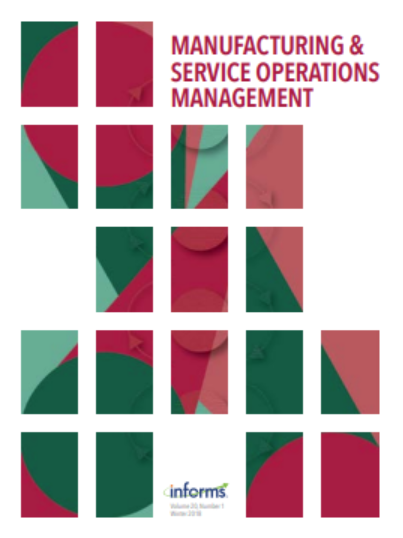On the Interplay of Production Flexibility, Capital Structure, and Investment Timing
IF 4.8
3区 管理学
Q1 MANAGEMENT
M&som-Manufacturing & Service Operations Management
Pub Date : 2023-09-25
DOI:10.1287/msom.2022.0213
引用次数: 0
Abstract
Problem definition: Modern technologies have made it viable for firms to lower the costs of switching on and off production in response to market changes. In this paper, we explore how production start–stop flexibility impacts joint operating policies, financing, and investment timing decisions. Methodology/results: We develop a continuous-time, optimal stopping model in which equity holders of the firm make operational decisions regarding pausing and restarting production as well as when to default. The degree of production flexibility is measured by switching costs. On the one hand, production flexibility influences the trade-off between tax shields and default costs for the capital structure decision; on the other hand, debt levels impact the equity holders’ incentive to use flexibility by pausing and restarting operations. We find that optimal debt usage is not monotone in production flexibility. Specifically, when switching costs are in a low region, the optimal debt level decreases slowly as switching costs increase. As switching costs increase into an intermediate region, the optimal debt level decreases sharply because the firm needs to reduce its debt to ensure the equity holders maintain flexible operating policies. However, when switching costs exceed a threshold, the cost of compromising the use of debt becomes excessive, and the firm substantially increases its debt to gain the full benefit of the tax shield; in so doing, the equity holders forgo flexibility and maintain production continuously until default. This financing strategy affects the firm’s investment timing decision, which also exhibits a nonmonotone pattern. Managerial implications: When a firm optimizes the debt usage and investment timing, the incentive of utilizing flexibility embedded in the production technology by the equity holders needs to be taken into account. Our findings also reveal new benefits and guidance for the potential design of incentive contracts to mitigate agency costs. Funding: Q. Wu was supported by Weatherhead School of Management Intramural Grant [Grant IG121420-05-QXW132] for this research. Supplemental Material: The online supplement is available at https://doi.org/10.1287/msom.2022.0213 .论生产柔性、资本结构和投资时机的相互作用
问题定义:现代技术使企业能够根据市场变化而降低生产开关的成本。在本文中,我们探讨了生产启停灵活性如何影响联合经营政策、融资和投资时机决策。方法/结果:我们开发了一个连续时间的最优停止模型,在该模型中,公司的股东可以就暂停和重新启动生产以及何时违约做出运营决策。生产灵活性的程度是通过转换成本来衡量的。一方面,生产灵活性影响税收盾与违约成本之间的权衡,从而影响资本结构决策;另一方面,债务水平会影响股东通过暂停和重新启动业务来使用灵活性的动机。我们发现最优债务使用在生产灵活性中不是单调的。具体而言,当切换成本处于较低区域时,最优负债水平随着切换成本的增加而缓慢下降。当转换成本增加到一个中间区域时,最优债务水平急剧下降,因为企业需要减少债务以确保股东保持灵活的经营政策。然而,当转换成本超过一个阈值时,妥协使用债务的成本变得过高,企业大幅增加债务以获得税收盾的全部好处;这样一来,股权持有者就放弃了灵活性,继续维持生产,直到违约。这种融资策略对企业投资时机决策的影响也表现出非单调模式。管理意义:当企业优化债务使用和投资时机时,需要考虑到股东利用生产技术中嵌入的灵活性的激励。我们的研究结果还揭示了新的利益和指导的潜在设计激励合同,以降低代理成本。资助:吴q .本研究获得了Weatherhead管理学院校内资助[Grant IG121420-05-QXW132]。补充材料:在线补充材料可在https://doi.org/10.1287/msom.2022.0213上获得。
本文章由计算机程序翻译,如有差异,请以英文原文为准。
求助全文
约1分钟内获得全文
求助全文
来源期刊

M&som-Manufacturing & Service Operations Management
管理科学-运筹学与管理科学
CiteScore
9.30
自引率
12.70%
发文量
184
审稿时长
12 months
期刊介绍:
M&SOM is the INFORMS journal for operations management. The purpose of the journal is to publish high-impact manuscripts that report relevant research on important problems in operations management (OM). The field of OM is the study of the innovative or traditional processes for the design, procurement, production, delivery, and recovery of goods and services. OM research entails the control, planning, design, and improvement of these processes. This research can be prescriptive, descriptive, or predictive; however, the intent of the research is ultimately to develop some form of enduring knowledge that can lead to more efficient or effective processes for the creation and delivery of goods and services.
M&SOM encourages a variety of methodological approaches to OM research; papers may be theoretical or empirical, analytical or computational, and may be based on a range of established research disciplines. M&SOM encourages contributions in OM across the full spectrum of decision making: strategic, tactical, and operational. Furthermore, the journal supports research that examines pertinent issues at the interfaces between OM and other functional areas.
 求助内容:
求助内容: 应助结果提醒方式:
应助结果提醒方式:


